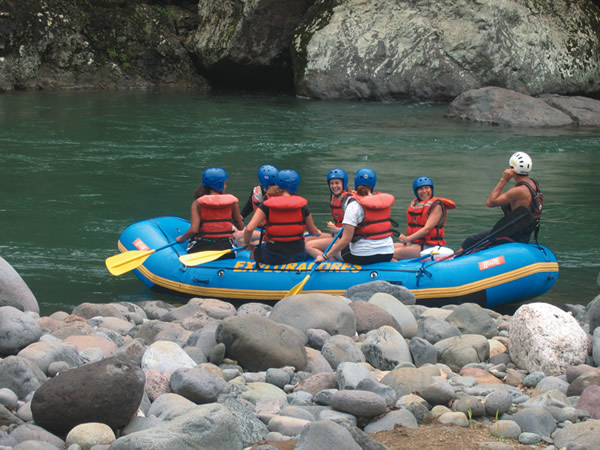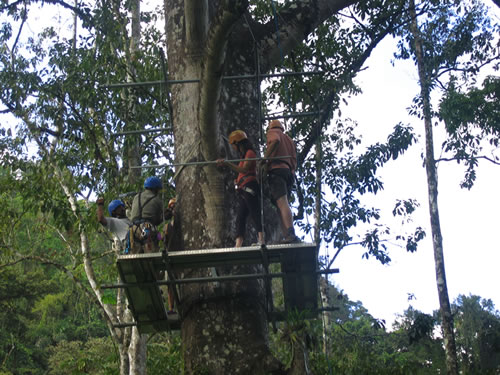Rafting to a Jungle Lodge in Costa Rica: A Responsible Adventure
Article and photos by Katherine McIntyre

|
|
We come and go by raft in Costa Rica.
|
“Forward, back, get down,” shouts Antonio, our river raft guide.
Rocks loom, the raft heaves as we navigate the raging rapids in Costa Rica’s fast flowing Pacuare River. “They’re only type two,” he yells, “wait until you get to type four.”
We bump and wind through rock canyon walls deep in the rainforest, over rapids sideways, backwards, past a cascading waterfall. The river widens, the turbulence ceases. We see the Pacuare Lodge’s thatched-roof bungalows.
This environmentally sensitive lodge, with its nine separate bungalows set in an untouched tropical wilderness, is the only lodge in the country where everything, including the guests, arrives by raft.
Our gear, safely stowed in bright red rubber bags, is unloaded. The manager greets us, “There is no electricity,” he warns. “Be sure and carry your flashlight to happy hour. It gets dark
at six o’clock.”
I reach my cabin, set among rare tropical plants and giant ceiba trees. In the screened bungalow, with its polished teak floors, there’s a queen-sized bed, down-filled pillows, plus a candle and wind-up flashlight
on the bedside table. The outdoor bathroom is hedged with a privacy screen of dark green foliage, and solar-heated hot water flows into a burnished copper sink. A lush arrangement of bright red tropical flowers rests beside a wooden stand holding
huge white towels.
A Responsible Adventure
The owners of this award-winning lodge are serious about preserving the fragile environment. Instead of cutting down endangered rainforest to build the bungalows, they brought in wood from a sustainable
tree plantation by raft. Local Cacebar Indians thatched the palm-leafed conical roofs in their traditional way.
At happy hour guests gather at the rustic bamboo bar upstairs in the main lodge to nibble on yucca chips and trade stories about the triumphs and pitfalls of traveling. This was only the prelude to a candle-lit gourmet dinner
served communal style on a long table in the lodge’s dining area. Any meal might include filet of fish baked in plantain leaves, accented with a touch of herbs, white wine and fresh cream, coupled with a local specialty of cassava, fried
bread fruit, or wild rice and organic garden vegetables. For a grand finale, there’s an organic chocolate tort laced with rum and topped with crystallized ginger. The river-guides-turned-waiters, wearing large white aprons, keep the wine
flowing.
Over the Top of the Rainforest
Trips usually last for two or three days and, unless guests are afraid of heights, they make the canopy tour over the tops of the rainforest, a once-in-a-lifetime experience. Jorge, the on-site expert, gives me the safety
talk and hands out a helmet, special vest, and heavy gloves. Feeling edgy, I climb to the first platform high in the branches of a giant ceiba tree. The view is astonishing, but the 500 meters of heavy steel wire connecting the stations, was
not reassuring. Jorge shouts tres, dos, and — at the sound of uno — I fly off the platform and find myself zipping over the canopy of the rainforest to station two. By the third station I relax. By the end of my two hours above the tree
tops I am hooked on canopy tours.

|
|
In the trees rappelling.
|
Besides the canopy tour you can hike through the lush rainforest, past crystal streams to the neighboring Cacebar Indian village. There, Zutkia the local shaman, relays stories of the first inhabitants of Costa Rica. Or
you can do as I did on a hot, humid day, meander through the gardens to swim in a cool pool underneath a cascading waterfall. Not to miss a beat, I rose at dawn for the daybreak tour to learn about orchids, bromeliads, the orange flowered amapolis,
and to add toucans and the Montezuma Oropenduala to my bird list.
Hopping on the Raft
And then it was time to hop in the raft for the rest of our 18 miles on the river. Bags stowed, we strap on our red life jackets and yellow helmets and within minutes the raft hurls into type four, the best and the worst
of the rapids. Spinning, dipping, and diving the raft seems out of control. “The Bronco’s coming up. There’s a hole in the right and one in the middle; we’ll go to the left,” shouts my river guide. We make it, and
the raft slips into safe pool beside the canyon wall.
The current slows and the river meanders into civilization. Cars whiz over a bridge. Soaked and laughing, we disembark. Our trip ends, and the Pacuare River — one of the five best rafting rivers in the world — continues
its journey to the Atlantic Ocean.
Katherine McIntyre has been a writer and world traveler
for over 40 years.
|
